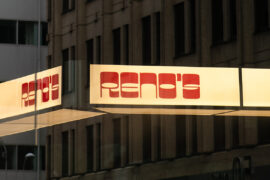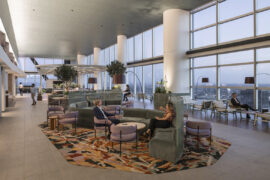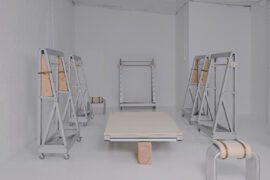Hames Sharley MD, Cailin Howard, and DWP’s Adelaide-based CEO, Michael Hegarty, how Adelaide’s planning has paid off in the 2021 Global Liveability Index.

July 7th, 2021
Adelaide has been ranked the world’s third most liveable city by the global index, moving up seven places to take the nation’s top spot from Melbourne. The Economist Intelligence Unit’s Global Liveability Index for 2021 ranks 140 cities worldwide based on the five categories: stability, healthcare, education, culture and environment and infrastructure.
Six of this year’s top 10 are from Australia and New Zealand, with Auckland recognised as the world’s most liveable city ahead of Japan’s Osaka.
It is Adelaide’s highest ranking on the index since 2015 when it placed fifth and represented a seven-spot increase from a 10th place finish in 2019.

Designed by Woods Bagot, the Australian Bragg Centre is a new clinical and research facility coming to Adelaide that began construction in July 2020.
The index gave Adelaide a perfect score for the categories of healthcare and education, as well as a 96.4 for infrastructure, a 95 for stability and an 83.8 for culture and environment.
The report’s authors attributed Adelaide’s high rating to its closed international borders and noted the pandemic had caused “high volatility” for other cities in this year’s index.
Wellington and Tokyo rounded out the top five, while Perth (#6), Melbourne (#8) and Brisbane (#10) were the other Australian cities to make the top 10.
Sydney – which ranked third in the 2019 index – this year placed 11th, while Melbourne – which was rated the world’s most liveable city from 2011 to 2017 – was relegated to joint-eighth after finishing second in 2019.

Hames Sharley has been responsible for a number of significant developments contributing to Adelaide’s liveability score, Rundle Mall Plaza being one of them.
Hames Sharley managing director Cailin Howard says his hometown Adelaide has “always done well” in the EIU’s index but it was particularly pleasing to see this continue in the wake of the pandemic.
“These rankings can influence where highly skilled migrants choose to work,” Howard says. “This most recent ranking means Adelaide is well placed to attract those workers, and subsequently benefit from the added economic and cultural vitality they bring with them.”
“This title attracts new business and investments, can boost local economies and real estate markets and fosters community involvement and pride particularly in the workplace – and it’s great for attracting talent.”

On the residential design front, Glenside Botanica Apartments by Hames Sharley is one of Adelaide’s beacons of design for multi-residential living.
“We are so proud of major developments that play a part in Adelaide’s infrastructure, some of which include Adelaide Oval, North Terrace Cultural Precinct, Rundle Mall Plaza, Glenside Botanica Apartments and Bowden Apartments.
Michael Hegarty, the Adelaide-based CEO of Design Worldwide Partnership (DWP), adds: “This isn’t something that arises by accident. Adelaide is a carefully designed city based from the outset on walkability distances and access to parks. We owe a great deal of the city design to William Light, who researched both European and Asian cities as models for Adelaide almost 200 years ago. These high-quality design interventions have continued over the years and are showcased today in the South Australian Architecture Awards.”

Adelaide has a number of significant projects currently on its agenda, such as the Aboriginal Art and Cultures Centre (AACC), designed by Diller Scofidio + Renfro and Woods Bagot.
COVID lockdowns across Europe saw the region record a massive liveability slump, with only the Swiss cities of Zurich (#7) and Geneva (#8) finishing in the top 10. The Canadian cities of Calgary, Vancouver and Toronto also dropped out of the top 10.
“The extent to which cities were sheltered by strong border closures, their ability to handle the health crisis and the pace at which they rolled out vaccination campaigns drove significant changes in the rankings,” Hegarty says.
According to the report, the average score for culture and environment worldwide fell by 14 points compared to pre-pandemic levels, primarily due to curbs on public gatherings.
However, the authors state that cities in Australia and New Zealand have primarily been able to lift these social and cultural restrictions and reverse negative trends in the culture and environment category.

Adelaide Contemporary, also designed by Diller Scofidio + Renfro and Woods Bagot, is another current work in progress sure to add to Adelaide’s ‘culture and environment’ score upon completion.
Hegarty comments that the South Australian Government has taken many innovative steps in infrastructure for Adelaide over the years, including the O-Bahn high-speed bus route, Adelaide Oval redevelopment and the South Australian Health and Medical Research Institute (SAHMRI). “These design interventions pay off in creating a long-term benefit for the people of the city.”
Howard highlights Adelaide’s vibrant arts culture as an essential reason for the city’s top-three ranking. “Globally, we see the rise of medium-sized cities like Adelaide which offer all the benefits of city living without the congestion and cramped living.”
INDESIGN is on instagram
Follow @indesignlive
A searchable and comprehensive guide for specifying leading products and their suppliers
Keep up to date with the latest and greatest from our industry BFF's!

For a closer look behind the creative process, watch this video interview with Sebastian Nash, where he explores the making of King Living’s textile range – from fibre choices to design intent.

In an industry where design intent is often diluted by value management and procurement pressures, Klaro Industrial Design positions manufacturing as a creative ally – allowing commercial interior designers to deliver unique pieces aligned to the project’s original vision.

Designed by RADS, the space redefines the lobby not as a point of passage, but as a destination in itself: a lobby bar, a café, and a small urban hinge-point that shapes and enhances the daily rituals of those who move through it.

Designed by Woods Bagot, the new fit-out of a major resources company transforms 40,000-square-metres across 19 levels into interconnected villages that celebrate Western Australia’s diverse terrain.

The Simple Living Passage marks the final project in the Simple World series by Jenchieh Hung + Kulthida Songkittipakdee of HAS design and research, transforming a retail walkway in Hefei into a reflective public space shaped by timber and movement.
The internet never sleeps! Here's the stuff you might have missed

The Simple Living Passage marks the final project in the Simple World series by Jenchieh Hung + Kulthida Songkittipakdee of HAS design and research, transforming a retail walkway in Hefei into a reflective public space shaped by timber and movement.

Melbourne-based Studio Edwards has designed Shift+Space, a modular system under the banner of ‘adaptive retail architecture’. Ben Edwards tells us more.